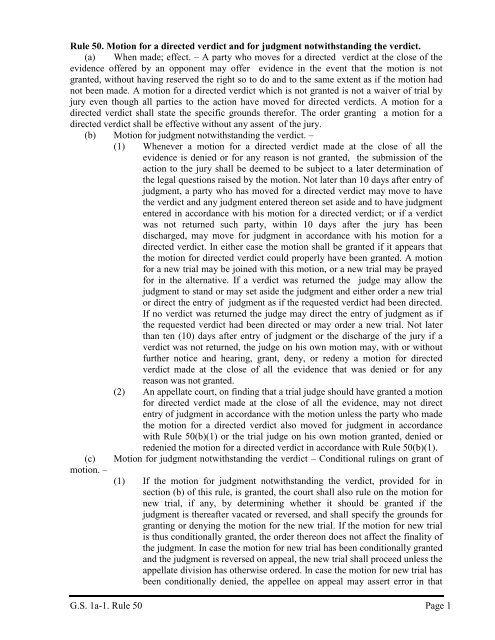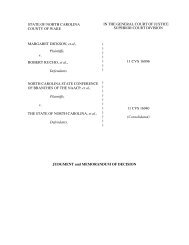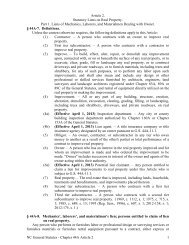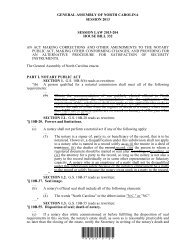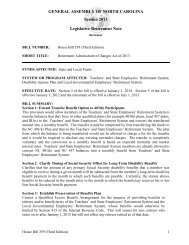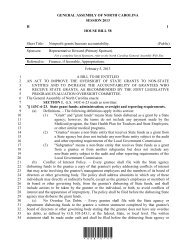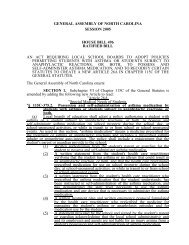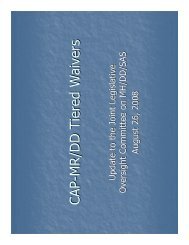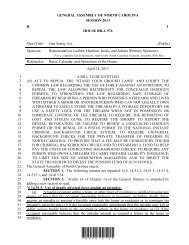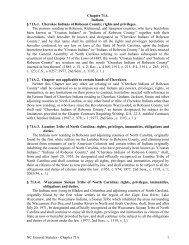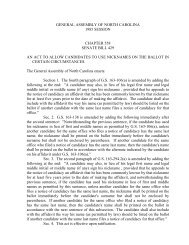Rule 50. Motion for a directed verdict and
Rule 50. Motion for a directed verdict and
Rule 50. Motion for a directed verdict and
You also want an ePaper? Increase the reach of your titles
YUMPU automatically turns print PDFs into web optimized ePapers that Google loves.
<strong>Rule</strong> <strong>50.</strong> <strong>Motion</strong> <strong>for</strong> a <strong>directed</strong> <strong>verdict</strong> <strong>and</strong> <strong>for</strong> judgment notwithst<strong>and</strong>ing the <strong>verdict</strong>.<br />
(a) When made; effect. – A party who moves <strong>for</strong> a <strong>directed</strong> <strong>verdict</strong> at the close of the<br />
evidence offered by an opponent may offer evidence in the event that the motion is not<br />
granted, without having reserved the right so to do <strong>and</strong> to the same extent as if the motion had<br />
not been made. A motion <strong>for</strong> a <strong>directed</strong> <strong>verdict</strong> which is not granted is not a waiver of trial by<br />
jury even though all parties to the action have moved <strong>for</strong> <strong>directed</strong> <strong>verdict</strong>s. A motion <strong>for</strong> a<br />
<strong>directed</strong> <strong>verdict</strong> shall state the specific grounds there<strong>for</strong>. The order granting a motion <strong>for</strong> a<br />
<strong>directed</strong> <strong>verdict</strong> shall be effective without any assent of the jury.<br />
(b) <strong>Motion</strong> <strong>for</strong> judgment notwithst<strong>and</strong>ing the <strong>verdict</strong>. –<br />
(1) Whenever a motion <strong>for</strong> a <strong>directed</strong> <strong>verdict</strong> made at the close of all the<br />
evidence is denied or <strong>for</strong> any reason is not granted, the submission of the<br />
action to the jury shall be deemed to be subject to a later determination of<br />
the legal questions raised by the motion. Not later than 10 days after entry of<br />
judgment, a party who has moved <strong>for</strong> a <strong>directed</strong> <strong>verdict</strong> may move to have<br />
the <strong>verdict</strong> <strong>and</strong> any judgment entered thereon set aside <strong>and</strong> to have judgment<br />
entered in accordance with his motion <strong>for</strong> a <strong>directed</strong> <strong>verdict</strong>; or if a <strong>verdict</strong><br />
was not returned such party, within 10 days after the jury has been<br />
discharged, may move <strong>for</strong> judgment in accordance with his motion <strong>for</strong> a<br />
<strong>directed</strong> <strong>verdict</strong>. In either case the motion shall be granted if it appears that<br />
the motion <strong>for</strong> <strong>directed</strong> <strong>verdict</strong> could properly have been granted. A motion<br />
<strong>for</strong> a new trial may be joined with this motion, or a new trial may be prayed<br />
<strong>for</strong> in the alternative. If a <strong>verdict</strong> was returned the judge may allow the<br />
judgment to st<strong>and</strong> or may set aside the judgment <strong>and</strong> either order a new trial<br />
or direct the entry of judgment as if the requested <strong>verdict</strong> had been <strong>directed</strong>.<br />
If no <strong>verdict</strong> was returned the judge may direct the entry of judgment as if<br />
the requested <strong>verdict</strong> had been <strong>directed</strong> or may order a new trial. Not later<br />
than ten (10) days after entry of judgment or the discharge of the jury if a<br />
<strong>verdict</strong> was not returned, the judge on his own motion may, with or without<br />
further notice <strong>and</strong> hearing, grant, deny, or redeny a motion <strong>for</strong> <strong>directed</strong><br />
<strong>verdict</strong> made at the close of all the evidence that was denied or <strong>for</strong> any<br />
reason was not granted.<br />
(2) An appellate court, on finding that a trial judge should have granted a motion<br />
<strong>for</strong> <strong>directed</strong> <strong>verdict</strong> made at the close of all the evidence, may not direct<br />
entry of judgment in accordance with the motion unless the party who made<br />
the motion <strong>for</strong> a <strong>directed</strong> <strong>verdict</strong> also moved <strong>for</strong> judgment in accordance<br />
with <strong>Rule</strong> 50(b)(1) or the trial judge on his own motion granted, denied or<br />
redenied the motion <strong>for</strong> a <strong>directed</strong> <strong>verdict</strong> in accordance with <strong>Rule</strong> 50(b)(1).<br />
(c) <strong>Motion</strong> <strong>for</strong> judgment notwithst<strong>and</strong>ing the <strong>verdict</strong> – Conditional rulings on grant of<br />
motion. –<br />
(1) If the motion <strong>for</strong> judgment notwithst<strong>and</strong>ing the <strong>verdict</strong>, provided <strong>for</strong> in<br />
section (b) of this rule, is granted, the court shall also rule on the motion <strong>for</strong><br />
new trial, if any, by determining whether it should be granted if the<br />
judgment is thereafter vacated or reversed, <strong>and</strong> shall specify the grounds <strong>for</strong><br />
granting or denying the motion <strong>for</strong> the new trial. If the motion <strong>for</strong> new trial<br />
is thus conditionally granted, the order thereon does not affect the finality of<br />
the judgment. In case the motion <strong>for</strong> new trial has been conditionally granted<br />
<strong>and</strong> the judgment is reversed on appeal, the new trial shall proceed unless the<br />
appellate division has otherwise ordered. In case the motion <strong>for</strong> new trial has<br />
been conditionally denied, the appellee on appeal may assert error in that<br />
G.S. 1a-1. <strong>Rule</strong> 50 Page 1
denial; <strong>and</strong> if the judgment is reversed on appeal, subsequent proceedings<br />
shall be in accordance with the order of the appellate division.<br />
(2) The party whose <strong>verdict</strong> has been set aside on motion <strong>for</strong> judgment<br />
notwithst<strong>and</strong>ing the <strong>verdict</strong> may serve a motion <strong>for</strong> a new trial pursuant to<br />
<strong>Rule</strong> 59 not later than 10 days after entry of the judgment notwithst<strong>and</strong>ing<br />
the <strong>verdict</strong>.<br />
(d) <strong>Motion</strong> <strong>for</strong> judgment notwithst<strong>and</strong>ing the <strong>verdict</strong> – Denial of motion. – If the<br />
motion <strong>for</strong> judgment notwithst<strong>and</strong>ing the <strong>verdict</strong> is denied, the party who prevailed on that<br />
motion may, as appellee, assert grounds entitling him to a new trial in the event the appellate<br />
division concludes that the trial court erred in denying the motion <strong>for</strong> judgment notwithst<strong>and</strong>ing<br />
the <strong>verdict</strong>. If the appellate division reverses the judgment, nothing in this rule precludes it<br />
from determining that the appellee is entitled to a new trial, or from directing the trial court to<br />
determine whether a new trial shall be granted. (1967, c. 954, s. 1; 1969, c. 895, s. 11.)<br />
G.S. 1a-1. <strong>Rule</strong> 50 Page 2


